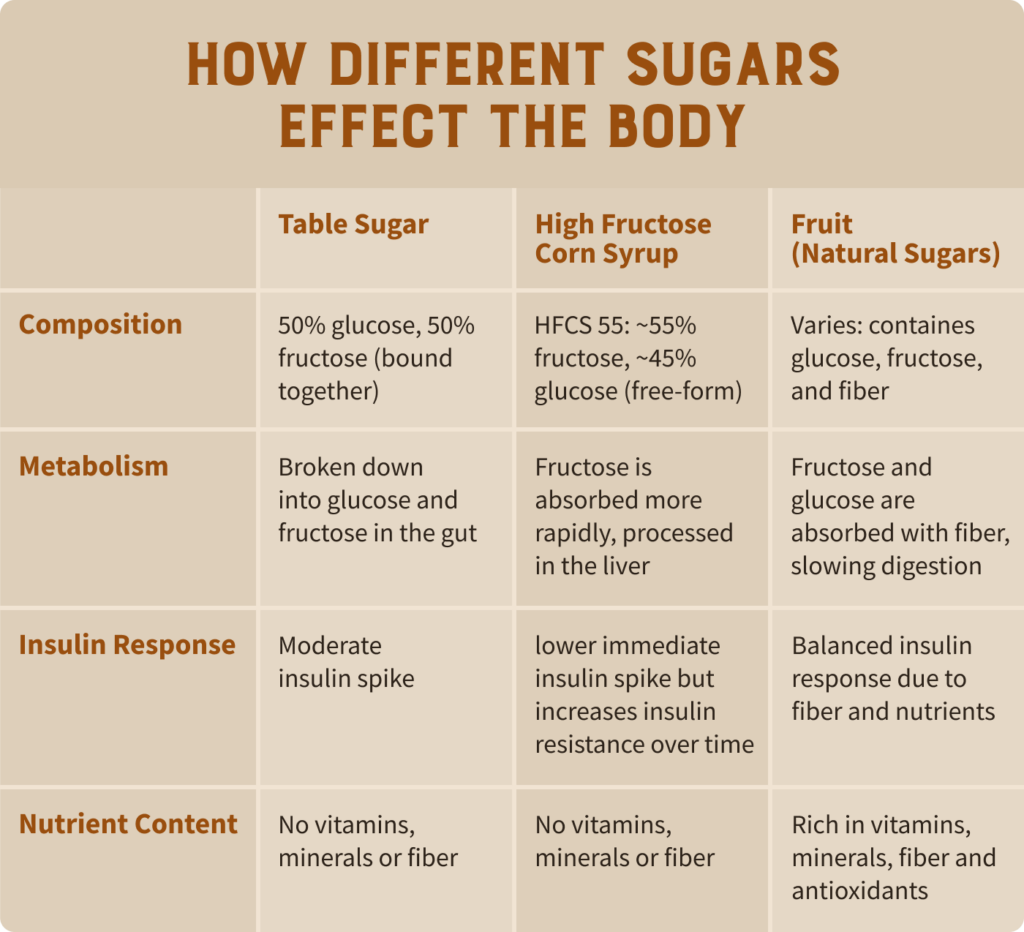PLEASE NOTE: The information in this blog is for educational purposes only. It is not a substitute for professional medical advice. Consult your healthcare provider if you’re seeking medical advice, diagnoses, or treatment.
High fructose corn syrup (HFCS) has been controversial since it began appearing in processed foods nearly 50 years ago. While many assume it’s no different from regular sugar, scientific evidence suggests otherwise.
The high fructose corn syrup dangers to be aware of go far beyond empty calories, and understanding the risks can help you make informed choices about your diet and long-term health.
What You’ll Learn
- The history of high fructose corn syrup
- How the body metabolizes high fructose corn syrup
- The 5 biggest dangers of high fructose corn syrup
- How to avoid high fructose corn syrup
- The best sugar sources for optimal health
What Is High Fructose Corn Syrup?
High fructose corn syrup is a highly processed sweetener made from cornstarch. Through enzymatic processing, some glucose is converted into fructose, resulting in various solutions of high fructose corn syrup, with the most common being HFCS-55 (55% fructose).

An Industrialized History
High fructose corn syrup was introduced to the food industry in the 1970s as a cheaper, sweeter alternative to cane sugar. Due to government corn subsidies, it became significantly more inexpensive than sugar, leading food manufacturers to replace traditional sweeteners with it.
By the 1980s, major beverage companies like Pepsi and Coca-Cola had switched from cane sugar to high fructose corn syrup, a dominant ingredient in the American food supply by the 1990s (1).
Several countries, including Ireland, India, Sweden, and Austria, banned high fructose corn syrup banned high fructose corn syrup. Still, it is the most commonly used added sweetener in the U.S., appearing in thousands of processed foods, from cereals and baked goods to dressings and dairy products. In 2018, Americans consumed an average of 22.1 lbs of high fructose corn syrup per person, fueling rising concerns about its effects on health (2).
How Does High Fructose Corn Syrup Affect the Body?
Unlike table sugar (sucrose), which has a bound 50-50 mix of glucose and fructose, the fructose in high fructose corn syrup is free and unbound, making it more rapidly absorbed and metabolized in the liver. This unique metabolic impact makes high fructose corn syrup particularly concerning for health.
Not all carbohydrates are created equal. Look at this table for an overview of the difference between table sugar, high fructose corn syrup, and fruit.

5 High Fructose Corn Syrup Dangers
Here are 5 key dangers to be aware of:
1. Fatty Liver Disease
One of the biggest high fructose corn syrup dangers is its impact on the liver. Since high fructose corn syrup is primarily processed in the liver, consuming too much can overwhelm the organ, leading to increased fat accumulation in liver cells.
Over time, this can result in non-alcoholic fatty liver disease (NAFLD), a condition that contributes to insulin resistance, metabolic dysfunction, and liver inflammation (3).
2. Increased Risk of Type 2 Diabetes
Unlike glucose, which stimulates insulin release, high fructose corn syrup does not trigger the same response, leading to higher blood sugar levels over time. Excessive consumption can increase metabolic dysfunction, a key driver of type 2 diabetes (4).
Studies suggest that high fructose corn syrup impairs glucose tolerance even when total calorie intake is controlled, meaning its effects go beyond excess calories (5). Countries with high availability of high fructose corn syrup have a 20% higher prevalence of diabetes compared to countries with low HFCS consumption, even after adjusting for BMI and other factors (6).
3. Obesity and Increased Appetite
High fructose corn syrup is widely used in processed foods because it’s cheap and highly palatable. However, it doesn’t activate leptin, the hormone responsible for signaling fullness and regulating appetite. This makes it easier to consume excessive calories without realizing it, contributing to weight gain and an increased risk of obesity-related diseases (7).
4. Chronic Inflammation
Another of the major high fructose corn syrup dangers to be aware of is its ability to promote inflammation. Its metabolism generates uric acid, which can trigger oxidative stress and inflammatory pathways in the body.
Compared to table sugar (sucrose), high fructose corn syrup is associated with higher C-reactive protein levels, a key inflammatory biomarker (8, 9). Chronic inflammation is a root cause of numerous diseases, including heart disease, arthritis, and neurodegenerative conditions like Alzheimer’s (10).
5. Leaky Gut
Excess high fructose corn syrup can overwhelm the small intestine, allowing undigested fructose to reach the colon and feed harmful gut bacteria. This imbalance contributes to intestinal permeability, allowing endotoxins produced by gut bacteria to enter the bloodstream and trigger systemic inflammation (11, 12).
How to Avoid High Fructose Corn Syrup Dangers
Since high fructose corn syrup hides in many processed and packaged foods, here are some strategies to avoid it:
- Choose whole, unprocessed foods. Focus on fresh meats, dairy, eggs, and fruit, which provide natural nutrients without hidden sweeteners.
- Read ingredient labels. High fructose corn syrup lurks in beverages, canned goods, condiments, and packaged snacks—if you see “high fructose corn syrup” (or “corn syrup”), put it back on the shelf.
- Prioritize homemade meals. Many restaurants (especially fast-food chains) use high fructose corn syrup in sauces, dressings, and even bread. Cooking at home gives you full control over ingredients.
- Drink fresh juice and milk. Sodas, sports drinks, and flavored beverages are major sources of high fructose corn syrup. Instead, opt for raw milk, fresh-squeezed juice, or homemade electrolyte drinks. Check out this easy recipe to make your own healthy soda here!

The Best Sugar for Optimal Health
Natural sources of carbohydrates like raw honey and organic fruit, are the best alternatives to high fructose corn syrup. These whole-food sources of sugar provide beneficial nutrients, enzymes, and antioxidants while supporting metabolic health. Unlike high fructose corn syrup, they help regulate blood sugar more effectively and don’t overwhelm the liver.
Instead of high fructose corn syrup, opt for natural, nutrient-dense sweeteners that support metabolism without the harmful effects:
- Ripe Fruits – Provides natural sugars, fiber, vitamins, and antioxidants.
- Raw Honey – A great source of glucose and fructose, plus enzymes and minerals.
- Maple Syrup – Contains minerals and a balanced glucose-to-fructose ratio.
The Bottom Line
High fructose corn syrup is more than just another sweetener—it’s a metabolic disruptor contributing to liver issues, insulin resistance, inflammation, gut dysbiosis, and more.
Eliminating high fructose corn syrup from your diet and replacing it with natural, whole-food carbohydrate sources, such as fruit and raw honey, is one of the most impactful steps you can take to improve your energy, metabolism, and overall well-being.
Subscribe to future articles like this: